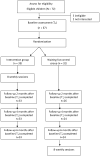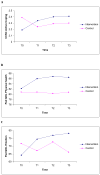The Active Balance Childhood program for improving coping and quality of life in Chinese American children
- PMID: 20585223
- PMCID: PMC2943857
- DOI: 10.1097/NNR.0b013e3181e507c7
The Active Balance Childhood program for improving coping and quality of life in Chinese American children
Abstract
Background: Interventions to teach children healthy and effective coping skills could help reduce their risk of becoming overweight. However, few studies have examined whether an intervention that teaches coping strategies in weight management can influence children's coping behavior and psychosocial well-being.
Objective: The purpose of this study was to examine the efficacy of an interactive, a child-centered, and a family-based program in promoting effective coping, behavioral health, and quality of life in Chinese American children.
Methods: This study used a randomized controlled study of behavioral intervention in 67 Chinese American children (ages 8-10 years, normal weight and overweight) and their families. At baseline and 2, 6, and 8 months after baseline, children had anthropometric measurements and completed questionnaires related to coping skills and quality of life, and parents completed the Child Behavior Checklist.
Results: Children in the intervention group reported using more active coping strategies and having a higher quality of life in the physical and emotional health domains than did children in the control group during the 8-month study. Children's behavioral problems did not differ between the intervention and the control groups. Changes in coping and psychosocial well-being were not related to change in body mass index in the entire group, except increased body mass index is associated with decreased emotional quality of life.
Discussion: This culturally appropriate behavioral intervention was effective in promoting healthy coping and in improving quality of life in Chinese American children. Its utility for both optimal weight and overweight children suggests potential application of the intervention in a broad range of populations.
Figures
References
-
- Achenbach T. Manual for the Child Behavior Checklist/4 – 18 and 1991 Profile. Burlington, VT: University of Vermont Department of Psychiatry; 1991.
-
- Anderson SE, Cohen P, Naumova EN, Jacques PF, Must A. Adolescent obesity and risk for subsequent major depressive disorder and anxiety disorder: Prospective evidence. Psychosomatic Medicine. 2007;69(8):740–747. - PubMed
-
- Ayers TS, Sandler IN, West SG, Roosa MW. A dispositional and situational assessment of children’s coping: Testing alternative models of coping. Journal of Personality. 1996;64(4):923–958. - PubMed
-
- Bandura A. Social foundations of thought and action: A social cognitive theory. Upper Saddle River, NJ: Prentice Hall; 1986.
-
- Bauer DJ, Curran PJ. Probing interactions in fixed and multilevel regression: Inferential and graphical techniques. Multivariate Behavioral Research. 2005;40(3):373–400. - PubMed
Publication types
MeSH terms
Grants and funding
LinkOut - more resources
Full Text Sources
Medical



